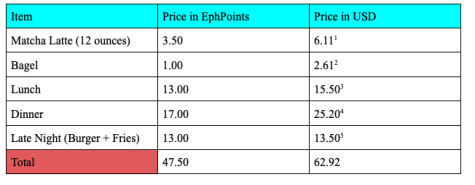What is the value of an EphPoint?
March 15, 2023
There is nothing quite as fundamental to the Williams College economy as the EphPoint. Unique to the College, it can be used in a variety of places, from Goodrich Coffee Bar to vending machines to dining. Yet we know little about how much an EphPoint is worth compared to a U.S. dollar.
Determining the value of a currency typically requires some knowledge about the aggregate supply and demand for that currency. In the case of the EphPoint, however, this is difficult. Despite my appeals to President Maud S. Mandel, the EphPoint is not freely traded on the forex market, or any market for that matter. Nevertheless, we can use proxy measures such as those used for other blocked currencies to estimate the value of an EphPoint in a specific market. For our purposes, we can look at the market for meals.
The first step is to find the nominal exchange rate of an EphPoint compared to a U.S. dollar. This information is actually quite easy to find because the College accepts both EphPoints and U.S. dollars for most of its dining products. The College charges a one-to-one ratio for these transactions, suggesting that one EphPoint is traded at one U.S. dollar.
Skeptics among you may rightfully point out that it would be absurd to trade one EphPoint for one U.S. dollar. Indeed, one cannot access nearly the same array of goods and services with an EphPoint as one can with the U.S. dollar. Thus, we must find an adjusted exchange rate which considers the relative purchasing powers of the EphPoint and U.S. dollar. To do this requires an understanding of the cost of a typical “basket” of goods and services in the Williams College EphPoint economy compared to the U.S. economy. This method is called finding a purchasing power parity. In our case, because there are certain goods and services that can be bought with the U.S. dollar but not with EphPoints, we will find a partial purchasing power parity.
In order to do so, we can construct a table looking at the difference in prices between goods typically bought with EphPoints at Goodrich or Dining Services compared to those bought with dollars at cafes or restaurants in Williamstown. We will do this for an average day with all three meals. This will yield a comparison for the power of EphPoints compared to U.S. dollars when it comes to meals.
The implied purchasing power ratio from the table below is roughly 0.75. Since we saw before that the nominal exchange rate was one-to-one, we can correct for partial purchasing power parity by multiplying our purchasing power ratio by our nominal exchange rate. This tells us that 0.75 EphPoints are worth one U.S. dollar. Or in other words, one U.S. dollar is equivalent to 1.33 EphPoints.

It should be noted that this is a partial purchasing power parity adjustment. It is an extremely simplified model. In particular, this conversion is only applicable for foodstuffs, and more specifically, meals from dining halls compared to Williamstown restaurants. However, if you are like me and that is 99 percent of your consumption here, then you have an answer to the question: How much are my EphPoints worth?
I am sure many of you may feel EphPoints are worth even less, and this would definitely be true if we considered the power of EphPoints outside the market for meals. My response to you is this: What do you envision for the future of the EphPoint? I, for one, believe that if we allow EphPoints to be freely traded, the superiority of Williams College as an exporter of education would inevitably make the value of EphPoints rise and make us all rich. As we continue to look for free-market currencies to drive the future, the answer may not be in cryptocurrency or fintech, but in the currency we all desire the most: the EphPoint.
Utsav Bahl ’25 is from Geneva, Switzerland.
1. Dunkin Donuts in Williamstown + tax
2. Dunkin Donuts in Williamstown + tax
3. Blue Mango Lunch Deal + drink + tax + 18-percent tip
4. Blue Mango Entree + drink + tax + 18-percent tip
5. The Log Cheeseburger + tax + tip








